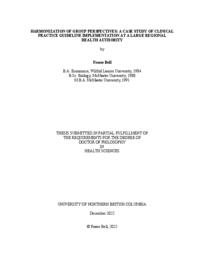Bell, Fraser
Person Preferred Name
Fraser Bell
Related Works
Content type
Digital Document
Description / Synopsis
Policy makers, health industry leaders, clinicians and researchers struggle to understand how new evidence-based practices, including Clinical Practice Guidelines (CPGs), can be implemented more quickly and more consistently. This retrospective qualitative case study explored sepsis CPG implementation at a British Columbia Regional Health Authority (RHA) between 2011-2017 to understand how individuals and teams with various functions and decision-making purviews come together to implement a prioritized CPG in a large RHA. The study was informed by practice theory and designed to provide practical guidance as to how CPG implementation might be better supported. Interviews involved 38 participants reflecting three functional groups: academics, regional managers and support staff, and clinicians. Over 350 documents and implementation process and outcome data were analyzed. The CPG implementation process was dynamic, involving different activities and intensities of involvement of individuals from each of the three groups. The three groups each behaved in a manner consistent with what some practice theorists call a community of practice. Individuals from each community of practice (COP) had a different perspective about the implementation along five dimensions (focus and rationale, vision, priority, appropriate balance and application of power, and goals, strategies and actions to be taken). The different COPs undertook actions that were consistent with their own COP perspective but not sufficiently aligned to ensure adherence to the CPG. The result was a discordant, and unsuccessful implementation. CPG adherence was not achieved. The differences in perspectives among the three COPs were substantial and appeared to have been deeply rooted in the beliefs, functions, experiences, and day-to-day realities of each of these groups of participants. The discordance in the implementation resulted from an insularity of each COP from the others, brought about by inadequate engagement among participants; insufficient connections across COPs to support shared understanding and alignment of action. Without some intervention, differences in perspectives will prevail and discordance is the likely outcome of any complex CPG implementation. This dissertation proposes the novel concept of harmonization as a means of achieving more successful CPG implementation; a process intended to reduce insularity of individual COPs within and beyond a RHA. Harmonization is conceptualized as a process comprised of many harmonizing activities that support engagement, relationship-building and explicit reflection and reconciliation of key differences in perspective among the three COPs. As a relational process, harmonization is largely determined by longstanding, contextual factors that support connections and collaboration among COPs. Widely engaging, horizontal, service-oriented improvement structures (with clear supporting roles and processes) establish a foundation for harmonization. Ongoing local interprofessional learning and improvement activities are essential to ensuring that the service improvement benefits from strong clinical engagement. RHA managers, particularly clinical managers, can support harmonization by encouraging open sharing of perspectives and managing in a way that is responsive to the realistic ebbs and flows of the implementation process. Harmonization integrates and builds upon many known CPG implementation determinants and strategies to bring a practical focus for future research and action.
Origin Information

